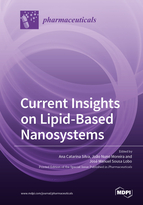Current Insights on Lipid-Based Nanosystems
A special issue of Pharmaceuticals (ISSN 1424-8247). This special issue belongs to the section "Pharmaceutical Technology".
Deadline for manuscript submissions: closed (15 June 2022) | Viewed by 71992
Special Issue Editors
2. Associate Laboratory i4HB - Institute for Health and Bioeconomy, Faculty of Pharmacy, University of Porto, 4050-313 Porto, Portugal
3. FP-I3ID (Instituto de Investigação, Inovação e Desenvolvimento), FP-BHS (Biomedical and Health Sciences Research Unit), Faculty of Health Sciences, University Fernando Pessoa, 4249-004 Porto, Portugal
Interests: nasal and cutaneous drug delivery; nose-to-brain delivery; lipid nanoparticles; biopharmaceuticals; biological medicines; advanced therapy medicinal products (ATMPs)
Special Issues, Collections and Topics in MDPI journals
Interests: cancer; liposomes; drug targeting; translational research
Special Issues, Collections and Topics in MDPI journals
Interests: pharmaceutical technology; biopharmacy; pharmacokinetics; pharmaceutical nanotechnology
Special Issues, Collections and Topics in MDPI journals
Special Issue Information
Dear Colleagues,
Lipid-based nanosystems, including solid lipid nanoparticles (SLN) and nanostructured lipid carriers (NLC), cationic lipid nanoparticles, nanoemulsions, and liposomes, have been extensively studied to improve drug delivery through different administration routes. The main advantages linked to these systems are the ability to protect, transport, and control the release of lipophilic and hydrophilic molecules (either small molecular weight or macromolecules), the use of generally recognized as safe (GRAS) excipients that minimize the toxicity of the formulations, and the possibility to modulate pharmacokinetics and enable site-specific delivery of encapsulated payloads. In addition, the versatility of lipid-based nanosystems has been further demonstrated through the delivery of vaccines, protection of cosmetic actives, or improvement of moisturizing properties of cosmetic formulations.
Currently, lipid-based nanosystems are well established, and there are already different commercially approved formulations in different human disorders. This success has actually paved the way to diversifying the pipeline of development, upon addressing unmet medical needs for several indications, such as cancer, neurological disorders, and autoimmune, genetic, and infectious diseases.
This Special Issue aims to update readers on the latest research with lipid-based nanosystems, both at the preclinical and clinical level. Submissions of original unpublished research work and review manuscripts are welcome.
Dr. Ana Catarina Silva
Guest Editor
Manuscript Submission Information
Manuscripts should be submitted online at www.mdpi.com by registering and logging in to this website. Once you are registered, click here to go to the submission form. Manuscripts can be submitted until the deadline. All submissions that pass pre-check are peer-reviewed. Accepted papers will be published continuously in the journal (as soon as accepted) and will be listed together on the special issue website. Research articles, review articles as well as short communications are invited. For planned papers, a title and short abstract (about 100 words) can be sent to the Editorial Office for announcement on this website.
Submitted manuscripts should not have been published previously, nor be under consideration for publication elsewhere (except conference proceedings papers). All manuscripts are thoroughly refereed through a single-blind peer-review process. A guide for authors and other relevant information for submission of manuscripts is available on the Instructions for Authors page. Pharmaceuticals is an international peer-reviewed open access monthly journal published by MDPI.
Please visit the Instructions for Authors page before submitting a manuscript. The Article Processing Charge (APC) for publication in this open access journal is 2900 CHF (Swiss Francs). Submitted papers should be well formatted and use good English. Authors may use MDPI's English editing service prior to publication or during author revisions.
Keywords
- solid lipid nanoparticles
- nanostructured lipid carriers
- cationic lipid nanoparticles
- liposomes
- nanoemulsions









